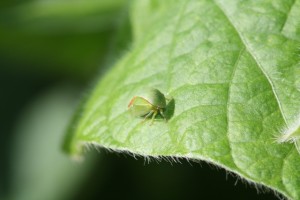Calls about various caterpillars in soybean have cooled down some this week, but we need to remain vigilant for a potential second bout of corn earworms. Moth traps have shown a rebound of corn earworms in some areas as larvae have cycled through to the next generation. Spraying twice for this pest is not common in Tennessee, but it is certainly possible. Again, use a treatment threshold of 9 larvae per 25 sweeps (36/100 sweeps). Good control has been reported from the suggested insecticide recommendations: 1) pyrethroid + 0.5 lb of Acephate/Orthene, 2) Steward at 6 oz/acre, and 3) Belt at 2 oz per acre. A straight pyrethroid should only be used when populations are only a little above the treatment threshold. Reports from my counterparts are that Belt has provided some extra residual control of corn earworm, sometimes preventing a second spray. It cost more, but Belt may also provide some protection from loopers down the road. It is just a guess whether this residual benefit will pay for the extra cost, but you may want to try some Belt or Steward on some acres if you have not already done so.

The knock on both Belt and Steward are they have little or no activity on non-caterpillar pests such as stink bugs. That is a true statement, but you need to ask yourself if you really have any non-caterpillar pests of concern? It is pretty unlikely stink bugs are near threshold levels in late maturing fields. Applications at this time (or with the fungicide) typically have little impact on stink bug populations that often start building as you approach R5. If you can’t see your target, then save your ammo! Many of the fields I’ve looked at in Madison County are nowhere near a treatment threshold for any pest. Having said that, I’ve also had calls this week about threshold levels of green cloverworm (threshold = 1.5 larvae per sweep) and threecornered alfalfa hoppers (threshold = 1 per sweep). These pests should be relatively easy to control with a standard rate of a synthetic pyrethroid (e.g., Asana XL, Baythroid XL, Declare, Karate, Mustang Max or one of the bifenthrin products). So make you insecticide decision based on scouting data!
I’ve had several questions about Leverage 360. This is a Bayer CropScience product that is a premix of Baythroid and imidacloprid (“Trimax”). Just to be clear, Leverage will have essentially identical activity on caterpillar pests (such as corn earworm) as a straight pyrethroid used at a comparable rate. The imidacloprid component has no activity on caterpillars. You might see some benefit of Leverage if brown stink bugs are present in appreciable numbers; same with bean leaf beetles. Frankly, switching to one of the bifenthrin products (Brigade, Fanfare, Discipline, etc.) might be a better choice for control of brown stink bugs. I’m not knocking Leverage. Just be sure to consider economics and pests spectrum when choosing an insecticide. I’ll remind you that quite a bit of insecticide efficacy data are available on the following web site: Midsouth Insecticide Evaluations.


Scott, I checked behind my worm sprays in the bottoms today (8-12-11). I was 9 DAA of Baythroid and orthene, I never had more than 6 CEW per 100 sweeps, but you could not take 1 step without flushing a moth. I have been doing this for 35 years, and this was as heavy as I have ever seen it. I’ll recheck in 5 days and I expect to have 2-3X threshold.
Thanks Billy. Hearing more of this as we are rolling through a second generation in beans. Let me know if you see any “failures” after a pyrethroid. I would like to collect larvae. I’m also looking for some wide rows to put a test out on earworms.